Lab Notes
Short stories and links shared by the scientists in our community
Mosquitoes can be genetically engineered to be resistant to malaria
But should they be?
Malaria is a mosquito-borne disease caused by the parasite Plasmodium that is responsible for over 400,000 deaths each year.
Countries have tried a variety of tactics to eliminate malaria: insecticides, anti-malarial drugs, bug netting – which have all reduced but not eliminated the disease. Many of these strategies try to disrupt the parasite’s lifecycle by exploiting Plasmodium’s dependence on hitching a ride in a mosquito to transmit to a new host.
A recent study turned the mosquito’s own immune system against the parasite. To do this they studied how Plasmodium infection affects the mosquito’s immune response. Specifically, they were looking for small pieces of RNA (called micro RNAs) that can stop other genes from being expressed.
They picked two micro RNAs that were regulated differently during infection and engineered mosquitoes to produce less of them, which resulted in a more active immune response. Both types of engineered mosquitoes were significantly more resistant to malarial infection.
If these genetically engineered mosquitoes were introduced into the wild using a gene drive, the mutation could spread through the population, making mosquitoes resistant to malaria and stopping the spread to humans.
Combining this with other malaria-resistance mutations in mosquitoes may provide a way to wipe out malaria worldwide. The idea to genetically modify mosquitoes as a way to stop malarial transmission has been proposed before. However, there is concern that genetic engineering may have adverse effects on ecosystems in ways that we can’t predict. Is it worth the risk if we have the chance to eradicate a disease?
That is a decision for bioethicists, scientists, and other informed parties to make.
Fat cells remember their diets early in life
No one likes to diet, and understanding how our bodies respond to calorie restriction at different points in time could help us avoid it
By Brenda Godinez on Unsplash
Studies in animal models, including mice, have demonstrated that dietary restriction, or reducing our calorie intake (but not to the point of malnutrition) can help us live longer. Usually, researchers restrict the animals’ diet very early on in their lives and thus we do not know whether those positive effects extend later in life.
A new study led by Oliver Hahn of the Max Planck Institute for Biology of Ageing examined the influence of early- and late-onset dietary restriction on the lifespan of mice. They compared mice that could eat as much as they liked with those on a restricted diet. For half of the mice, their diets were switched when they had reached about two thirds of their maximum age.
Switching the mice from a diet were they could each as much as they liked to a restricted diet late in life only slightly increased their lifespan. It did not yield the positive effect that can be obtained with whole life dietary restriction. And mice that were allowed to eat as much as they wanted after dietary restriction early in life had a shorter lifespan compared to those that continued the restricted diet. However, they still lived longer than mice that could eat as much as they wanted all the time.
The researchers found that fat cells appeared to "remember" the unrestricted diet. Their functions seemed programmed to their early-life diet, and they were not able to adapt completely to the new diet. Switching in the other direction did not reveal such a memory.
Understanding the interplay between nutritional memory and dietary restriction, and their effects on how long we live, may eventually help to develop effective diets which are not strictly dependent on reduced food intake.
A bit of obligation binds us together, but too much breeds resentment
New research in psychology focused on middle-aged adults and their social relationships
Photo by Matteo Vistocco on Unsplash
Many of us haven’t seen our friends or family outside of Zoom in weeks, if not months. Social distancing is hard, and only getting harder.
And yet, relationships find a way. We still feel obligated to check in on our parents, join virtual work happy hours, and bring groceries to elderly neighbors. Does this sense of obligation bring us closer together, or fuel resentment that drives us apart?
The short answer: it’s complicated.
Psychology researchers at Michigan State University found that not all obligations are created equal. They analyzed the results of an 18-year-long study of middle-aged adults and their relationships, and observed that while some obligation strengthens bonds, too much obligation breaks them.
Light obligation, like sharing a virtual glass of wine with an old college friend, was correlated with improvements in well-being across the board. But when favors become disruptive or financially burdensome, the trend flips: substantive obligation was linked to more depressive symptoms and increased strain on friendships over time.
This study was one of the first to investigate how obligation impacts relationships in middle-aged adults, a largely underlooked demographic in the field. Amidst this pandemic, many middle-aged adults find themselves caught in an impossible relationship juggling act. Working from home while taking care of children, connecting with romantic partners while checking in on elderly parents — obligation may be the glue holding us together, whether we like it or not.
Black scientists are exposing the racist side of academia on Twitter
#BlackintheIvory is yet another illustration that academia is rife with racism. It's long past time for change
Photo by Andre Hunter on Unsplash
Academia, including the sciences, is rife with racism. This is not news to Black professors, researchers, and graduate students, who are often reluctant to share their stories because of potential backlash and retaliation from their superiors and peers. But Dr. Shardé Davis of the University of Connecticut and Joy Melody Woods, a PhD student at the University of Texas-Austin have changed that, by starting a Twitter conversation using the hashtag #BlackintheIvory.
Black scientists have been posting about their experiences, which range from repeated microaggressions to physical threats. One common theme is of white academics not believing that Black scientists are who they say they are. Another is of white faculty telling Black students that they won't be successful in their chosen field/program. A third is Black academics being prominently featured in university brochures and "diversity and inclusion" media, but never recognized otherwise. But this summary can't do the range of stories justice — go read them for yourself.
An important point that many Black scholars have made in addition to these stories is that they are just the ones that people feel safe sharing publicly, and they don't include stories from Black people who were pushed out of academia before reaching the "ivory tower." There are countless others that are more horrifying that will remain untold. And the sheer volume of stories drives home the point that this is a systemic problem that should not be swept under the rug as isolated instances or just the viewpoints of a few old, white men who should get a pass because they are "from another time" (to be clear, they should not).
Dr. Davis was shocked that the hashtag that she had started became such a sensation, but she wasn't surprised at the volume of stories that Black academics had bottled up. "White academics need to know that we [Black academics] are hurt. And that intention doesn’t matter. What matters is the impact of their behavior... I’m not shocked by the volume of responses to #BlackintheIvory because these are the stories that we often share in Black-only spaces. The current socio-political climate emboldened Black academics to speak their truth and Joy and I simply created the space," she said to me in an interview.
I asked her if she was hopeful that things would change now that such a strong spotlight has been shined on anti-Black academic racism. "I have some hope. I think that there are a number of white academics, university presidents, deans, provosts, and the like who are getting it in a way that they haven’t before. Prior to this moment in time, many white academics knew that racism existed; they knew that Black folks could experience racial macro and microaggressions, but I don’t think those academics thought that it could be them causing the harm. I think some, (not all) but some were oblivious to their complicity in perpetuating anti-Black racism in the academy."
But there is a limit to her hope: "Are we going to move from white folks understanding it to white folks leveraging their privilege to enact structural change and bringing Black academics along, and compensating us for our time as we work with the university to make that structural change? That part, I don’t know. Time will tell if folks do what they are supposed to do to make structural change in a way that is appropriate. Meaning, we [Black academics] don’t need people making decisions on our behalf. We need our white colleagues to leverage their racial privilege to draw attention to these issues and to ensure that we are integrally involved when those conversations occur and decisions are made."
Your brain rewards you when you explore new places
A new study used questionnaires and MRI scans to get to the heart of a similarity with rat brains
Photo by Alessandro Erbetta on Unsplash
Does staying in the same place all day seem to suck the joy out of your life? Science says you’re not alone. A new study from researchers at the University of Miami and New York University has shown that humans, just like lab rats, seem happier when they experience more novel environments.
Researchers tracked the movements of more than 100 participants over the course of three months. During this time, participants also completed mood questionnaires every other day. On the days that participants visited more places that they’d never been before, they also reported increases in positive mood.
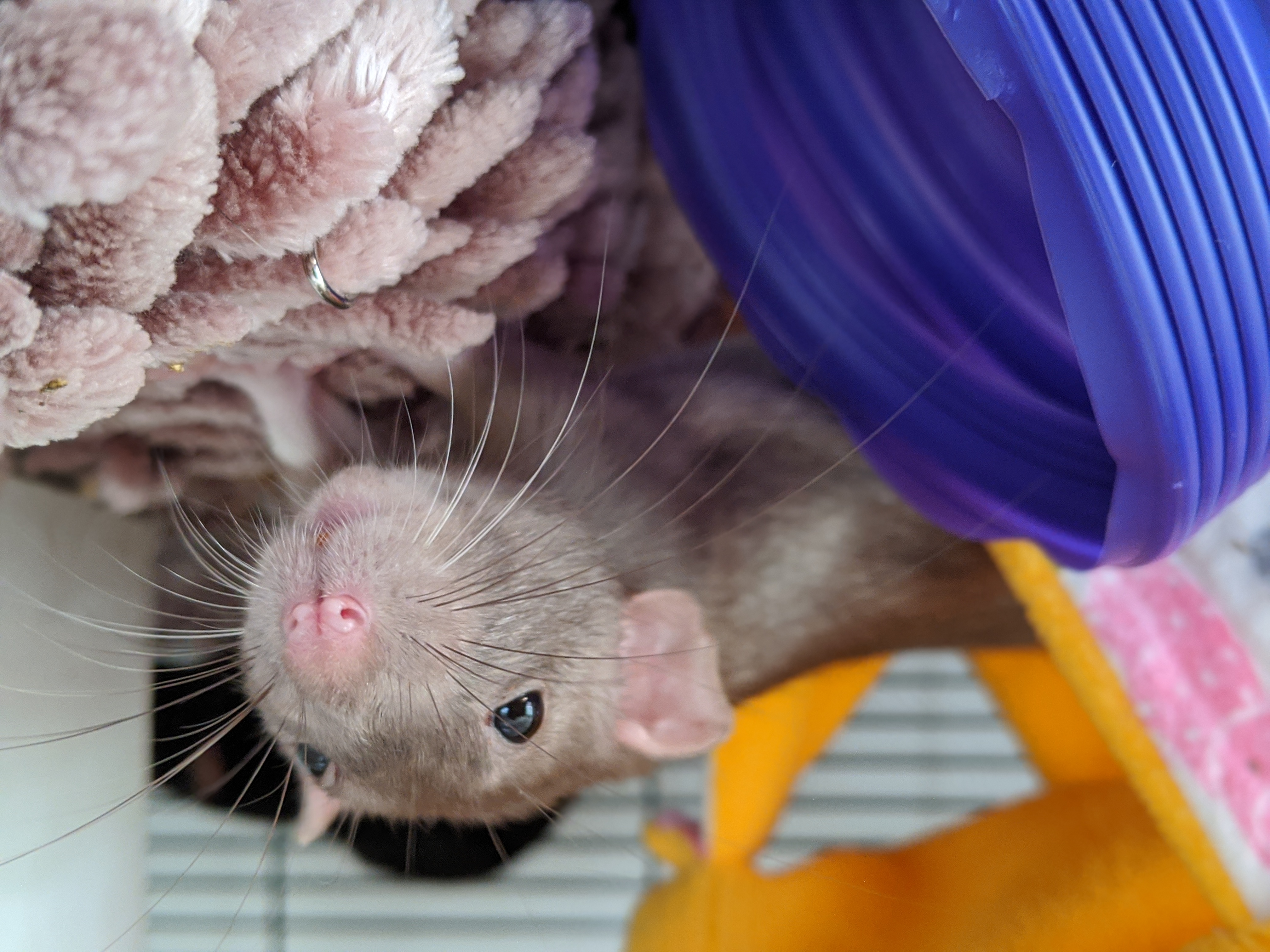
Humans, just like lab rats, seem happier when they experience new environments
Max Levy
Researchers also scanned participants’ brains using functional MRI – a technique that measures blood flow in different brain regions as a proxy for brain activity. Participants who had greater improvements in mood when they traveled around more also had greater functional connectivity between two brain regions – the striatum and the hippocampus – that are associated with reward processing and novelty detection. This suggests that connectivity between these two areas may underlie the positive feelings that new experiences can bring us.
There's an additional environmental toll to nuclear warfare
A "nuclear winter" could cause the worst famine the world has ever seen
Photo by Science in HD on Unsplash
Almost 30 years after the end of the Cold War, the threat of nuclear Armageddon seems like a thing of the past. Even though tensions over the Kashmir region between India and Pakistan and the U.S.’s withdrawal from the Iran nuclear deal have increased the threat of the use of nuclear weapons on a regional basis, fears of a cold, irradiated Earth are mostly gone. Unfortunately, Jonas Jägermeyr, his colleagues, and their models of global climate and food production aren’t convinced. According to their predictions, even a regional nuclear war holds the potential to plunge the world into a so-called "nuclear winter," with drastic consequences for global public health and food security.
The nuclear winter scenario was originally proposed in the journal Science by a group of scientists lead by Carl Sagan during the Cold War. It claims that the smoke and dust launched into the atmosphere by a series of nuclear detonations and the resulting mass firestorms has the potential to block out a portion of incoming sunlight to the Earth’s surface. That could dramatically influence global temperatures, destroy the ozone layer, and make it harder for crops to grow. Together, those factors make the food supply one of the most vulnerable systems in the event of a nuclear winter.

A nuclear conflict would have major implications for food production
That brings us back to the new simulations published this year and its predictions. According to the authors, “a regional conflict using <1% of the worldwide nuclear arsenal could have adverse consequences for global food security unmatched in modern history.” They predict a drop in average global food production of about 11% for up to 5 years, surpassing even the worst historical famines caused by volcanic winters.
That’s a terrifying result, although it is pessimistic. A recent competing study predicted a much milder nuclear winter effect. Even so, with the worst famine in modern recorded history on the line, it might be worth erring on the side of caution.
Adolescent dogs are less likely to listen to you
Even good boys have ruff teenage years
Photo by Simon John-McHaffie on Unsplash
Teenagers. The bundle of joy who was once your greatest fan suddenly doesn’t listen to a word you say. Hard, right? Turns out, dog parents suffer through these years, too. Teen canine unruliness and disobedience is a hot topic among dog owners. In the first study to investigate canine adolescence behavior, scientists at Newcastle University have underpinned what may be the cause of the ruff years between dog and caregiver.
The researchers followed a litter of 70 guide dogs to be. The breeds were German shepherds, golden and Labrador retrievers, and mixed breeds of the two. The dogs' attachment and attention-seeking behaviors towards their owners were measured and compared to the age of puberty. Female dogs that displayed insecure attachment and attention-seeking behaviors began puberty earlier than those which did not — mirroring the behavior of human adolescents who also suffer from rocky relations with their parents.
The second phase of the project saw the researchers scoring the obedience of 93 dogs toward both their main caregiver and a stranger at two time points: “adolescence” and “pre-adolescence.” Unfortunately for the caregivers, dogs responded less to the command of “sit” during adolescence. However, in a brazen act of teen rebellion, the dogs responded to the strangers' commands more during the adolescence period. This disobedience was heightened in dogs with insecure attachments.
Tying these experiments together are the results from a questionnaire the researchers sent out to understand the link between the two “attachment” and “trainability.” Separation-related behaviors increased at 8 months, alongside the obedience decreasing.
This could have a huge impact on the number of dogs relinquished to shelters each year, since most dogs in shelters are of adolescence age. Could the teen disobedience be something the owners cannot cope with? Could there be a way to reduce the number of teen dogs being relinquished? Furthermore, dogs could be used as a model of teen attachment behavior to understand high-risk and impulsive behaviors in at-risk teenagers.
Physicists measured general relativity's effects using clocks
The findings will let us apply the theory here on Earth
Photo by Malvestida Magazine on Unsplash
The theory of general relativity describes gravity and gravitational phenomena, usually having to do with really massive objects, like stars, black holes, whole galaxies. Physicists consider it a particularly elegant and significant theory. However, the conditions of our daily life are too “small-scale” for it to get involved.
Now, scientists set out to find if general-relativistic effects can be measured in everyday conditions. Not only did they succeed, they also made their point in a cool way. Even better? They made it possible to use general relativity for practical purposes here on Earth.
To begin with, the team formed by five Japanese research groups needed very precise clocks. Relativity says that time passes more slowly in stronger gravity, so the plan was to detect small changes in the ticking speed at different heights. The go-to choice for such precision is optical lattice clocks, where two lasers pointing against each other form “nodes” of light that trap atoms, vibrating in well-defined ways. The team added improvements to the quality of the atomic signal and fitted the system in a portable 60cm-tall box, as the whole point was to take gravity measurements out of the lab.
Selecting a real-world setting for the experiment mustn’t have been hard; the team picked Tokyo Skytree, an iconic television tower with a convenient public observation floor at 453 meters. After installing the clocks at the observatory and on the ground floor they spent five days measuring in October 2018.
The result was a tiny but clear shift in the frequency of the two identical clocks, with the one at the top of Skytree “ticking” faster. This shift allowed them to calculate the difference in the strength of Earth’s gravity between the two points, and from it the difference in height.

Tokyo Skytree
Photo by Spencer Chow on Unsplash
Moreover, the experiment’s accuracy permits the detection of a difference of even a few centimeters. This could turn gravity into our aid for detecting small position changes in places difficult to access — no wonder that one of the first applications could be in monitoring the motion of Earth’s crust.
A reading and listening list for scientific anti-racism
Angry about the murder of George Floyd? Want to learn more? Start here
Blaz Photo via Unsplash
This is a reading list for those interested in learning more about social justice issues, particularly if you're interested in a science-oriented angle.
If you are not sure where to start in the world of social justice, The Appeal has a series of explainers on topics like bail reform, qualified immunity, and the criminalization of homelessness.
They also have excellent coverage of policing, including articles on defunding and abolishing the police. Verso also offers The End of Policing as a free ebook right now. Below is a list of the Massive staff's favorite books in this area. Avoid purchasing from Amazon — instead, purchase from a Black-owned bookstore.
(IndieBound here)
Here are some of our favorite articles from other outlets:
And some podcasts:
Sick bees social distance, but only within their own colony
Bees from other colonies accepted infected bees with open arms where they usually would be rejected.
Damien Tupinier on UnSplash
Throughout evolution, animals have developed mechanisms to survive disease. In addition to the physiological response, the psychological response when encountering germs and disease helps us avoid them. Surprisingly, this response may help avoid the spread of disease to others. A new study found that bees apparently have behavioral changes that allow them to keep their colony safe from viral spreading — but to the detriment of neighboring colonies.
Researchers at University of Illinois at Urbana-Champaign tracked hundreds of bees after they infected them with a virus called Israeli acute paralysis virus (IAPV). The study showed that bees practiced a form of social distancing when infected: they avoided other bees from their colony and came into contact with healthy bees less than those that were not infected. By just stimulating the immune response of the bees (without viral infection), the bees behaved the same way, meaning that it was probably the immune response of the bee’s body that was driving this social distancing behavior.
But menacingly, the viral infection manipulated the bees to spread the virus to bees in other colonies. Since bees have their own cliques, or colonies to be scientifically accurate, “bouncer bees” typically guard the bee colony. These guards make the decision of letting other bees in based on the surface chemicals they carry which act as social signals.
They saw that bees from other colonies accepted the infected bees with open arms where they usually would be rejected. In this case, it seemed that the virus produced a different chemical composition in infected bees that allows them to be accepted into other colonies.
This way, the virus can increase its transmission, which has implications for commercial beekeeping operations in which bee colonies are kept in close quarters. Beekeepers may have to implement social distancing measures to keep their bees safe and healthy.
Neanderthals braided their own string
A 40,000 year old cord made of plant fiber provides unprecedented insight into our extinct relatives
Clemens Vasters on Wikimedia Commons
Our relationship to Neanderthals has been a point of contention for over a century. It all began with an inaccurate reconstruction of the first Neanderthal ever found, which portrayed them as brutish, stooped-over cavemen (turns out, that Neanderthal was an injured old man with arthritis).
But within the last half century, scientists have noticed the many biological and behavioral similarities that show just how close our species are. While these similarities are clear from hard objects like bones and tools, perishable objects, which comprise the majority of material culture items in humans, have been lacking.
Now, scientists have discovered a Neanderthal feat that hammers another nail in the coffin of supposed Neanderthal inferiority. Last month, an international team of researchers found a small section of a twisted cord attached to a stone flake in Neanderthal site in southeastern France, dated to over 40,000 years old. This constitutes the oldest direct evidence of fiber technology ever found.
.png)
A stone flake with three distinct twisted fibers preserved (indicated by the box).
M.-H. Moncel
When artifacts are recovered from archaeological sites, they are generally imaged using high powered microscopes to zoom in on tiny marks and details on the stones. Previously, plant fibers had been found on stones at this site, but they were too poorly preserved to be interpreted. When the team examined this particular flake, they were surprised to find three distinct twisted fibers, which were then twisted together in the opposite direction to form a 3-ply cord.
While it may not sound like much, this piece of string hints at something much more significant. For one, extracting and manipulating plant fibers requires working memory, as well as understanding plant seasonality and the concept of numbers. Also, such cords are the building blocks for creating other textiles, such as baskets, fabrics, and nets. Once adopted, these objects would have been indispensable in daily life.
This little piece of string provides unprecedented insight into the lives of our extinct relatives, which, despite an abundance of genetic, archaeological, and skeletal data, have been extremely difficult to interpret. It seems as though we humans aren’t as unique as we like to think.
Buckeye butterflies get their color from their scales
Nanostructures combine with pigments to form all the colors in the rainbow
Photo by Jan Haerer on Unsplash
Butterfly wings come in almost any color imaginable. In order to make these colors, they use a combination of structural color and pigments. Pigments are molecules that absorb or reflect certain colors of light, like the pigments in paint, whereas structural color is determined by the shape of nanostructures and the materials they are made of. A great example of this is the green forester moth, which can change its color by trapping moisture in the nanostructures on its wings.
A new study explored how buckeyes, butterflies from the genus Junonia, created their color, and how this trait was controlled by their genes. Scales on the wings of butterflies are made of chitin, and generally consist of two structures: ridges on top and a thin film below. The thickness of this film plays a role in the color the scale will have.
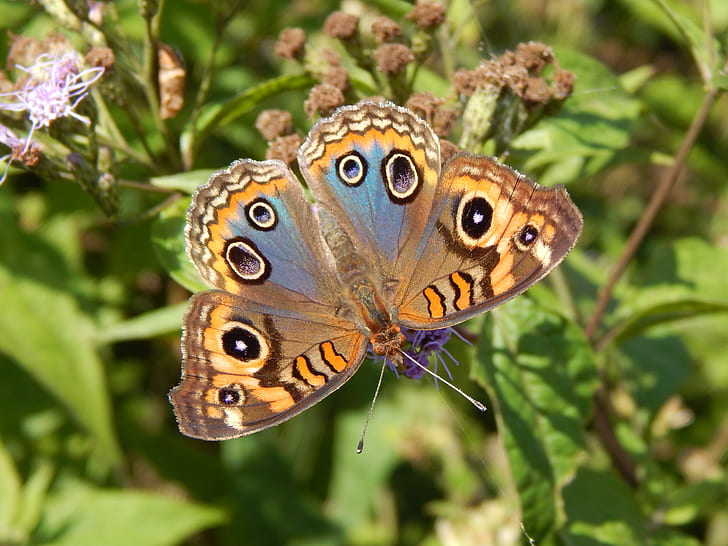
A buckeye butterfly
For their study the scientists used a special type of buckeye: one that was bred to be blue. Normally these butterflies are for the most part brown, but will have small patches of blue. Edith Smith, a professional butterfly breeder, selected the individuals with the largest patches and crossed them, until she eventually got butterflies that were for the most part blue instead of brown.
The main difference the researchers found between these special blue buckeyes and the normal brown ones, was the thickness of the film, also called the lamina, in their scales. By selecting the blue butterflies, the breeder had actually selected the butterflies with the thickest films, which was responsible for the color. They researchers also found that they could mimic this effect by deleting the optix gene, which is important for the color of butterfly wings.
These results are not just true for one species of buckeye. The researchers found this link between lamina thickness and color 10 different species of butterfly. Sadly, the lamina cannot make every color in the rainbow. So butterflies cannot just rely on their lamina, they also need to use pigments and other clever tricks to create their brilliant colors.
Cytokines prevent the whooping cough bacteria from invading the rest of the body (in mice)
Researchers hope that this finding will eventually lead to new treatment for the disease in infants
Photo by Jonathan Borba on Unsplash
Whooping cough, caused by Bordetella pertussis bacteria, causes 24.1 million cases and 160,700 deaths each year, according to the CDC. This is probably an underestimate, as many people don't report or aren't hospitalized for their illness, and thus are not counted in the total. Scientists are still trying to piece together the immune response we mount to the illness, particularly why whooping cough is most deadly in babies and toddlers.
Researchers from University of Maryland School of Medicine believe they have found part of the answer, and it lies in the differences in immune response between young children and adults. In this study, the researchers used lab mice infected with B. pertussis to mimic human infections, and studied the immune response following infection in infant and adult mice.
Type I and III interferons are cytokines, substances that are secreted by immune cells to signal that an infection is occurring. The elevated levels of Type I and III interferon seen in adult mice post-infection were not present in the infant mice in the study. The adult mice showed a delayed but significant increase in their interferon levels in the lungs, which stopped the bacterial infection from spreading throughout the body.
The infant mice had no interferon response, and as a result the B. pertussis bacteria were free invade the rest of the body. They eventually killed the young mice by stimulating an overwhelming, body-wide infection.
Could boosting interferon levels in babies and children improve their survival, and reduce mortality from this devastating disease? This, excitingly, opens a new door for pediatric whooping cough treatments.
The upside-down jellyfish stings you with mucus grenades
Scientists call these, "Cassiomes"... but that doesn't make them any less painful
© Raimond Spekking / CC BY-SA 4.0 (via Wikimedia Commons)
Swimmers have long been wary of the calm, placid waters where Cassiopea – the upside down jellyfish – are found. Many have experienced the itch and inflammation that follows a swim through the stinging water, where the jellyfish can deliver a nasty sting to humans or to small prey like shrimp without ever having direct contact. Now, a collaborative team of marine scientists affiliated with the National Museum of Natural History, the U.S. Naval Research Laboratory, the National Oceanic and Atmospheric Administration (NOAA), Tohoku University, and the University of Kansas have shown for the first time how the sting is carried through the water.
They found that the water around these jellyfish is filled with tiny mucus grenades containing structures they have named “Cassiosomes.” These are hollow balls of cells called nematocytes, responsible for delivering the jellyfish sting. The balls also contained cells with cilia, structures that help the mucus move rapidly.
Mucus itself is an important structural material in the aquatic environment. It is formed from a large protein that forms a strong watery gel, and has many different biological functions across many types of animals. A famous example from the marine environment is the hagfish, which produces huge amounts of mucus when threatened, using the slippery material to evade capture.
The hagfish produces mucus all over its body when poked. The team investigating the jellyfish grenades found that similar stimuli could provoke Cassiopea to release Cassiosome grenades from some tiny spoon-shaped structures on their arms. This is a fascinating finding, but it won't protect you from jellyfish stings – so next time you go swimming in warm, coastal waters, keep your eyes out for upside-down jellyfish (and their mucus)!
#BlackBirdersWeek highlights Black nature enthusiasts and scientists
The social media campaign was prompted in part by Christian Cooper's experience in Central Park
Photo by Slim Emcee on Unsplash
Last week, Christian Cooper was birdwatching in Central Park. Upon rightfully asking a woman to leash her dog in a protected area, a verbal altercation ensued and the woman called the police on Cooper, highlighting how dangerous the outdoors can be for Black birdwatchers.
Sadly, Christian Cooper’s experience is not an uncommon one. This tale resonated deeply with Black birdwatchers and nature enthusiasts, prompting the BlackAFInSTEM group (founded by Jason Ward) to launch #BlackBirdersWeek.
Starting from May 31, the #BlackBirdersWeek aims to celebrate Black nature enthusiasts and amplify their voices through various photo challenges (#PostABird, #BlackWomenWhoBird) and livestream chats. The co-founders of this week-long initiative include Anna Gifty Opoku-Agyeman, Danielle Belleny, Sheridan Alford, Tykee James, Joseph Saunders and Chelsea Connor.
“It is upsetting to see that it is still so unsafe for a lot of Black people to go outside, and to do what they love doing outside,” says Connor, who is a herpetologist, artist and science communicator. “A lot of us in the [BlackAFInSTEM] group are nature biologists. We have to go outside for work – to do fieldwork, collect our data and look at the animals we study out there.”
Connor’s research focuses on the differences in diet between native and invasive anole species found in Dominica. Anoles are a family of small to large lizards, where males often have a dewlap (a brightly colored flap of skin that extends from their throat).
“We wanted to highlight Black birders, amplify their voices, and make sure that people can see us. We want Black birders to be visible. We want people to know we’re out here. We bird as well. It’s not just for one race. It is important that we feel safe in the environment that we work in,” says Connor.
The BlackAFInSTEM group joined Twitter this past weekend, and has already amassed over 5,000 followers. At the time of writing this, #BlackBirdersWeek has kicked off with their first photo challenge: asking individuals to share their photos out in nature using #BlackInNature.
“The response has been amazing – I don’t even know how to describe it […] It’s just amazing to see the support we’re getting, and how our colleagues are amplifying our voices,” says Connor. “It is so vital that people hear our side of the story – that people hear what it is like just being Black, existing and doing some of the things that we love.”
Cyanobacteria detach their antennae to stop growing when space is limited
This new finding may make it easier for researchers to study these organisms, which have many practical applications, in the lab
Doc. RNDr. Josef Reischig, CSc. on Wikimedia Commons (CC BY-SA 3.0)
Take two deep breaths: you can thank phytoplankton for one of them. That’s because these tiny, plant-like organisms produce over half of the oxygen in our atmosphere, most of which comes from our oceans.
One of the most interesting types of phytoplankton are cyanobacteria. You may recognize the name from the news, because sometimes cyanobacteria become over-abundant in lakes and seas, causing harmful algal blooms. But in the open oceans, they're essential for life. Many cyanobacteria perform photosynthesis. They use special molecular ‘antennae’, called phycobilisomes, that capture energy from sunlight and use it to make sugars for the cells to grow.

Cyanobacteria "blooms" can be seen from outer space
NASA Goddard Space Flight Center
For years, scientists have been looking at ways to culture cyanobacteria in large volumes, for production of biofuels, or even to make buildings from living concrete. But it is not very easy to grow them in large amounts in a lab setting. A group of researchers at the University of Colorado were trying ways to track the growth of a single cyanobacterial cell when they noticed something odd. As the cells multiplied, they would start to grow more and more slowly, so they decided to investigate.
Using specially developed microscopy techniques, the researchers saw that the more cells multiplied, the more they squished their neighbors, until they stopped growing. By measuring the fluorescence of the cells with time-lapse imagery, the team discovered that more squished cells actually stopped photosynthesis. Apparently, when a cell has no more room to grow, it detaches its antennae to shut down photosynthesis! This prevents the cells from growing any larger.
This discovery shows how cyanobacteria have evolved ways to control their growth when caught in a tight spot. In the future, it could help scientists better understand how to grow these organisms in the lab, and how we can use them to make all sorts of renewable resources.
Tiger King exposed the dark side of for-profit zoos, but people have not gotten the message
The reason you say, "awwww" when you see a puppy is the same reason it is so difficult to convince people that baby tiger petting is wrong
Photo by Javier Virues-Ortega on Unsplash
Netflix´s hit series Tiger King is back for a new wave of attention since the main zoo (now owned by Jeff Lowe) depicted in the series re-opened during the first week of May to long queues and large crowds. Baby tiger petting sessions – one of the problematic activities portrayed in the show – are still being offered.
When the series first came out, several researchers, zookeepers and committees from serious accredited zoological facilities released statements against the practices it highlighted. The main criticism from animal welfare experts was the lack of information about the animals and their treatment. Some people hoped that shedding light on the problems of for-profit zoos would be a good result of the Tiger King frenzy. But judging from the crowds that the zoo saw on re-opening, that does not seem to be the case.
Humans often react to animals based on emotions and feelings, and forget about logic. There are quite a few studies about why we are fascinated by cute things and are drawn to baby animals. There is even some evidence that we drive artificial selection in pets, like rabbits, based on their cuteness factor. This is a problem.
As demonstrated by the wild popularity of baby tiger petting in the face of its dark backstory, logic goes out the window when a person finds out that they can cuddle a baby tiger. Most people out there are not animal specialists and will not think about questioning this activity. Now in the age of social media, they get to take a picture and brag about this “rare” event, making people want to do it even more. But this is enormously stressful for the baby tigers, who are kept from their mothers and possibly underfed or even drugged.
How can you avoid adding to this problem? Talk about it with your Tiger King-loving friends, and do your own research on the issue. Tigers and other wild animals face so many other threats these days – don't make them worse by supporting facilities that offer baby tiger petting sessions.
Deep-sea currents are spreading microplastics around the globe
Microorganisms on the sea floor ingest these plastics and can disrupt entire food webs
Photo by Thanos Pal on Unsplash
The "garbage patch" in the Pacific has long been the poster child of plastic pollution, but recently, microplastics — tiny particles of plastic that are resistant to breaking down — have been making headlines for their ability to travel far and wide at Earth's surface. But a new study in Science reveals that microplastics aren't just a surface problem — they can be concentrated in the oceans' deepest waters, which are home to the microorganisms that drive the marine food web.
The study reports an alarmingly high concentration of microplastics — 1.9 million particles per square meter — on the floor of the Tyrrhenian Sea, near Barcelona. That number is worrying in itself, but the bigger questions are how did it all got there and how it will affect ocean life.
The Tyrrhenian Sea receives microplastics from the crowded, industrial areas along the shore, as well as from fishing and shipping in the area. Previously, scientists thought that most of the microplastics found at the sea floor started at the surface near pollution sources, accumulated in certain spots due to surface currents (like the gyre that helps the Pacific garbage patch grow), and slowly sank down.

cheng xiao on Unsplash
The study found that rather than settling down onto the ocean floor, particles are carried along by cold, salty masses of water near the sea floor — not necessarily close to the pollution source. These waters, called thermohaline currents, circle around the globe and distribute the oxygen and nutrients essential for ocean life. Now we know that they're efficiently collecting and distributing microplastics, too.
Because these currents are also home to microorganisms at the base of the marine food web, microplastics at the seafloor have the potential to disrupt the ocean's food web from the bottom up. As microplastics build up in an organism, they can release harmful substances; everything from plankton to tuna can be affected.
Knowing that microplastics are gathering in deep-ocean waters is a worrying, but from here, we can begin to track them and study their effects on the oceans' food webs — and hopefully slow their spread.
"Directed evolution" gets around CRISPR's inherent limitations
New gene editing technology may make molecular scissors more useful
Wikimedia
DNA, the genetic material that produces life on Earth, is made of unique sequences known as “genes.” It's possible to edit those genes, using technology called CRISPR-Cas9. CRISPR essentially acts as a pair of molecular scissors to replace an existing gene by cutting the DNA at a desired sequence and swapping in a newer version.
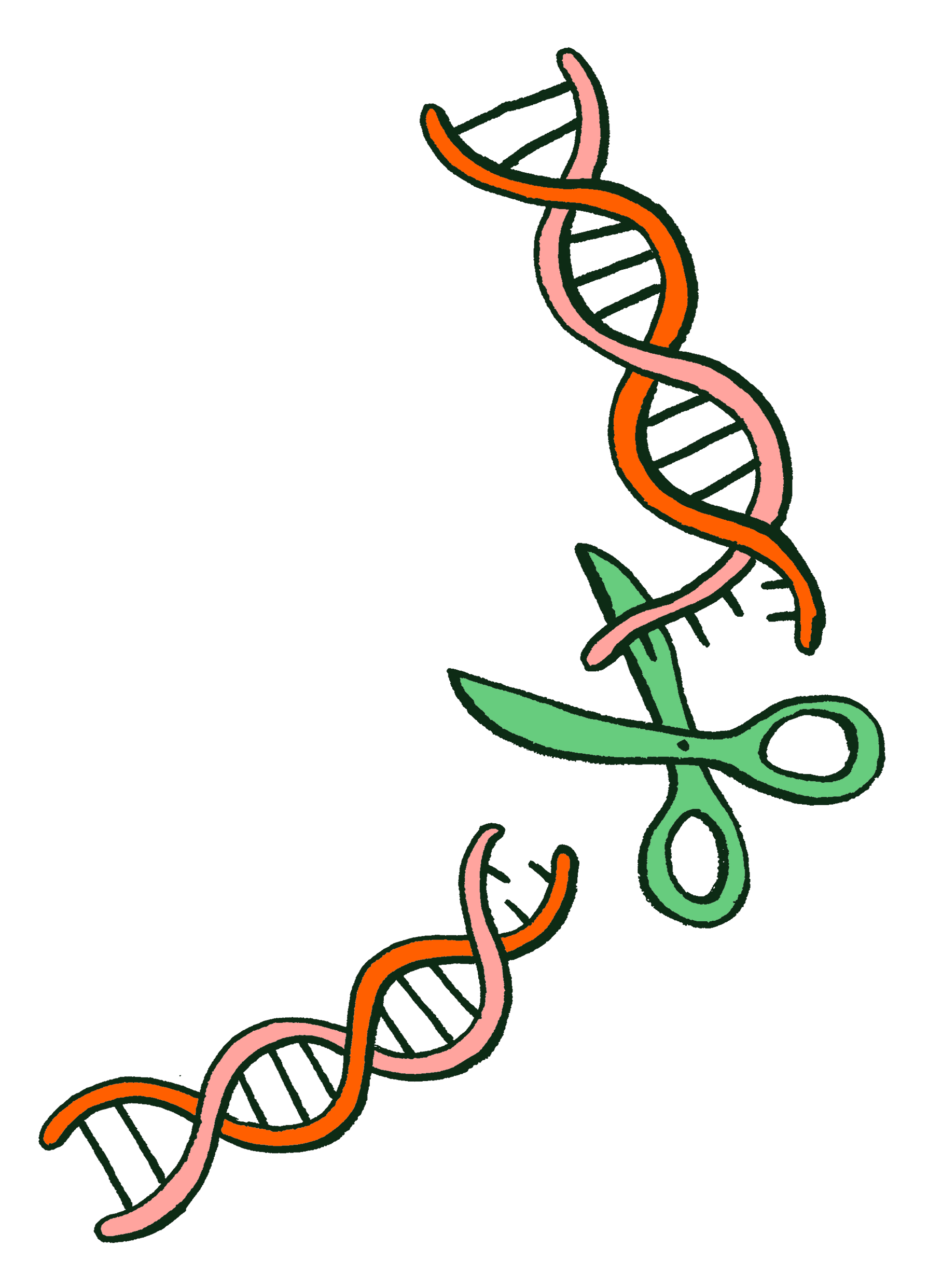
Matteo Farinella
In the case of a disease caused by a single mistake in a gene, this has huge potential – CRISPR could be delivered to the mutation and fix it by replacing the wrong sequence with the correct one. Applications of gene editing spread beyond gene therapy as well, from engineering more resilient crops to curbing insect-borne diseases and more. However, there’s a catch: in order for editing to occur, a short but highly specific sequence of DNA known as a ‘PAM’, must be located directly beside the editing sequence, like runway lights for a plane to land on.
In a recent study, scientists used cutting-edge research techniques to improve that system. Many diseases, including sickle cell anemia, are caused by mutations without a nearby PAM, ruling out CRISPR-gene editing as a potential treatment. The researchers in this study wanted to design new versions of CRISPR that could recognize more common PAMs, and could therefore reach more genes for therapeutic intervention.
To do this, they used a Nobel prize-winning technique known as directed evolution, a method to quickly make and test thousands of variants of CRISPR to design a more versatile version of the gene editor. The authors showed that the new CRISPR editors could repair the mutation causing sickle cell anemia. They might also have the be able to target far more single mutations that cause disease than ever before possible. While there are still challenges before CRISPR reaches the clinic, the results of this paper enormously increase the scope of medical, environmental, and agricultural impacts that gene editing technology can have on society.
Do people realize when they get distracted?
New research tests people's awareness of their own awareness
Visual search, or simply looking for something, is something people do daily. From scanning aisles for favorite products at the store to monitoring road conditions while driving, search is an essential function of human vision and attention. However, distractions can divert us, capturing our attention at inopportune moments.

Head in the sand
Wikimedia
But this isn’t always a negative. Our ability to get distracted plays an important role in alerting us to hazards, in advertising, and in education research. For example, bright, attention-grabbing colors are often used on road signs to alert us to important information. Metacognition, or self-knowledge about our thinking, can help us understand these real-world behaviors. But do people always know when they get distracted?
A new study published in Attention, Perception, and Psychophysics explored this question. Participants engaged in a series of computer-based search tasks where the goal was to find a target shape on the screen, situated among other shapes. In some trials, a colorful distracting shape was added to the array. After some trials with a "distractor" present, the researchers asked the participants to report whether or not they had been distracted. When the participants got distracted, it took them longer to perform the task at hand: reaction times are longer in these trials than in those when they weren’t distracted. By comparing these reaction times to participants’ claims of being distracted or not, the researchers came to a conclusion. People are typically aware of when they get distracted. However, performance wasn’t perfect, and study participants didn’t always catch when their attention had wandered.
This suggests that people can often, but not always, tell when they are distracted. This may lead us to a better understanding of how we cope with distractions, and future work may indicate how people can be more aware of distraction and learn how to avoid it when necessary.
Tracking specific hair cells reveals how stress causes gray hair
The science of why stress changes hair color
Photo by Helio Dilolwa on Unsplash
It's no surprise that chameleons can change colors to pink, blue, orange, red, and black. These color changes are partly mediated by stress. For example, stress increases dark gray pigmentation of tawny dragon lizards. That same stress and color change relationship also applies to human hair. Hair graying has long been associated with increased stress and aging. But little actual evidence as proven science behind this observation.
A team of scientists from Harvard University have now explained this mystery.
For hair follicles to grow, they go through three main phases: growth, degeneration and inactivity. The growth phase activates two population of stem cells, one called hair follicle stem cells, or HFSCs, and another called melanocyte stem cells, MeSCs. Activation of HFSCs produces hair follicles. Activation of MeSCs produces fully formed melanocytes, which migrate to the base of the hair follice and make the melanin that colors hair. Melanocytes die and degenerate, and the cycle repeats with a new cohort of melanin-producing cells.
But where in this cycle does stress play a role?
When researchers caused pain-induced stress in rats, it triggered a fight or flight response, which in turn increased production of noradrenaline. Noradrenaline, generally functions to increase action and attention in the mind and body and binds to the surface of MeSCs. This stress effect accelerated the MeSCs growth cycle, pushing the cells to become melanocytes and possibly causing them to migrate elsewhere.
After the end of a cycle of stressed hair follicle growth , remaining MeSCs were also reduced. Interestingly, decreased MeSCs also occur with age. That effect on MeSCs resulted in less mature melanocytes and thus less pigmentation in subsequent hair follicle growth cycles.
After years of empirical evidence, it is exciting to understand the role MeSCs may play in stress and if it contributes to the accelerated ageing process.
Ed.: Originally this article was published with an image of Claire Saffitz as an illustration of someone with gray hair. It was pointed out to me that this is an unfair and hurtful use of a person's appearance. I apologize for the error and have changed the photo to a stock image. -DS
The Milky Way's supermassive black hole might have enabled the evolution of life on Earth
Chemical reactions caused by the X-ray emissions from the black hole could have spurred water formation
Photo by Greg Rakozy on Unsplash
No matter which origin of life theory you subscribe to, water is a key component. A new pre-print study takes one step beyond to consider how water became so abundant in our galaxy, the Milky Way. The researchers present evidence that the Milky Way’s central supermassive black hole, Sagittarius A*, might have made the Milky Way a much nicer place to live.
When supermassive black holes consume galactic gas and dust, they emit huge amounts of radiation, temporarily becoming active galactic nuclei (AGN). Similar activity in other galaxies appears to correlate with an increased density of water and other organic molecules conducive to life, which occurs as X-rays from the AGN remove electrons from previously neutral atoms and molecules. This release of free electrons can accelerate the creation of organic molecules.
The researchers constructed a computer simulation of a molecular cloud containing dust grains and gaseous chemicals. They tested what would happen if they exposed the cloud to X-ray irradiation, like that from an AGN, for a million years. The AGN was then either switched off or allowed to continue emitting for a further 10 million years. Both these scenarios were compared to a simulated molecular cloud which experienced no X-ray irradiation.
When the AGN kept emitting X-rays, more water formed on the surface of dust grains in the molecular cloud compared to the model without irradiation, and this trend appeared even when the AGN was switched off. The explanation for this is that irradiation can increase the rate at which hydrogen molecules split, speeding up water formation.The simulation experiment also found that too many X-rays could eventually lead to a decrease in gaseous water, which suggests that there is a "sweet spot" for X-ray emissions where water can form and persist.
Computer models like these are complex with assumptions that may not perfectly reflect reality, but they can also be really useful for understanding past events. The study shows that X-ray emissions from an AGN could have a substantial effect on the abundance of water in the Milky Way.
When COVID-closed labs reopen, who will be there?
Coronavirus is going to make "normal" research impossible, so adjust your plans
National Institute of Arthritis and Musculoskeletal and Skin Diseases, NIH via Flickr
As research institutions in the US begin to plan for operations that look more like "normal," it's critical that we take an inclusive approach to reopening. Some labs – like the one I work in – are planning to open in a limited capacity in the next few weeks. There will be lots of restrictions in place to keep everyone safe, from temperature checks to required distancing, down to calculating the number of square feet per person. But as we reopen, we should make sure that all lab members are equally able to come to work. Here are a few questions to ask yourself, or your supervisor, as your lab plans to reopen.
Is anyone in a high risk group? What about their families and roommates?
When you read about how people at higher risk for severe illness should be extra careful, you may only think of older adults. But people with underlying medical conditions are also part of that group. You might not know that a grad student is on an immunosuppressant medication, or that a postdoc takes care of their grandparents on the weekends. How will your reopening plan impact those people? There are no easy fixes, but make sure you identify and respect people's boundaries around working in person.
Who is comfortable working alone?
Some lab work is inherently dangerous. With appropriate training and procedures, we decrease the risk of spilling large quantities of acid or starting a fire, but the risk never goes to zero. Working alone means that there might not be anyone around to help if an accident does happen. Is your institution's environmental health and safety department even working? Plus, survivors of trauma might feel unsafe or vulnerable as the only person in their lab, or one of few people in an entire building. To address some of these concerns, make sure your lab has emergency protocols in place and your building is secure. Allies are particularly important here: if you are not worried about working alone, you can volunteer for later shifts.
Have schools and childcare facilities reopened?
The pandemic is already having a disproportionate impact on women in academia. If labs reopen before childcare options are available, it's possible that mothers won't come back to reopened labs at the same rate that fathers do. Groups could allow caregivers to set their own schedules, like working every other day or at off-hours, or continuing to work remotely until their usual childcare is restored.
I don't have all the solutions to these considerations, but I do know that we need to put people before science. If we take an equitable look at our next steps, science will be better off.
Native bees are better for the environment and altogether cooler than honey bees
Celebrate native bees for World Bee Day, not imported honey bees
Honey bees have been celebrated by humans since they were first domesticated for pollination and honey production in the earliest days of human civilization. But honey bees are expendable — we can purchase them from other countries, ship them overseas, and raise them in a non-native land to pollinate our crops. If all of the honey bees in the U.S. died today, we’d buy more tomorrow. This World Bee Day, we should focus our celebration on the lesser-known species of amazing native bees that fill our environment.
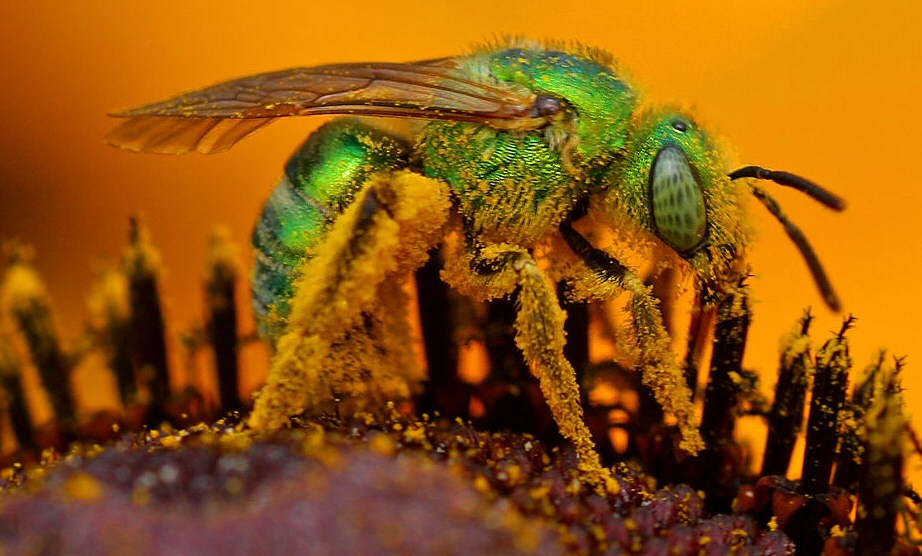
Iridescent green sweat bee, called because it is known to be attracted to sweat
Via Wikimedia
World Bee Day was established by the United Nations to recognize the fundamental role of pollinators in pollination services, food production, and to safeguard biodiversity in the face of their many threats. It was not only in recognition of honey bees and the pollination services they provide, but of all bees. The proclamation specifically acknowledged and raised awareness of the urgent need to conserve all of the 20,000 species of native bees worldwide.
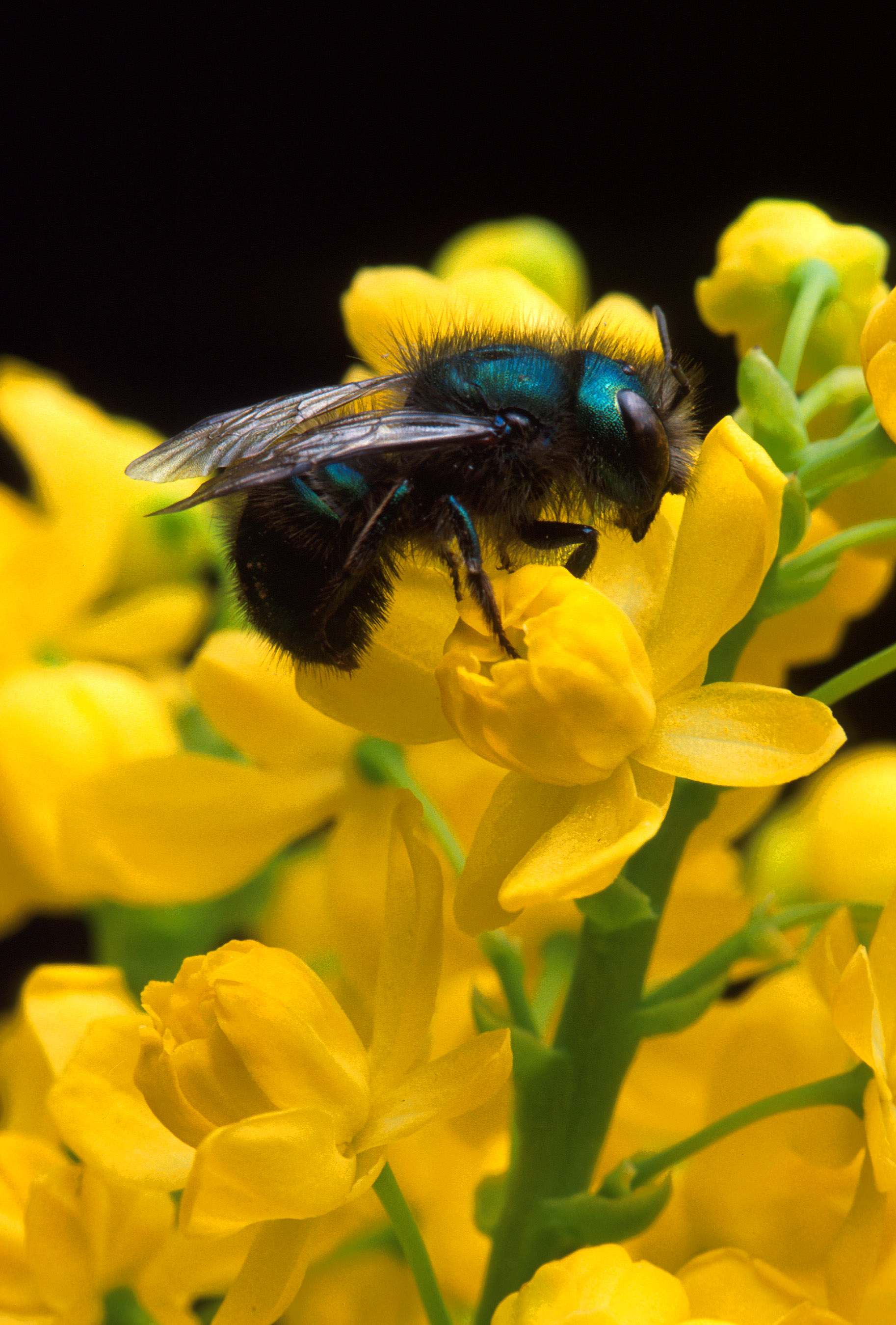
The blueberry bee, Osmia ribifloris, a blue-colored bee native to North America.
Via Wikimedia
Native bees are absolutely some of the coolest insects on earth. They come in a huge variety of shapes, sizes, and colors. Social species with a single queen — like bumble bees — make up about 10% of known bee species. Social bees live in nests and work together like honey bees to raise their young and forage for food. The other 90% are solitary species, meaning they live alone and are solely responsible for finding food and building a nest.

Stelis louisae, a red/orange carder bee
Native bees come in a variety of colors besides yellow and black — blue, green, orange, and red, to name a few. Some resemble wasps, as a defense mechanism for survival. Others are covered in tiny hairs, resembling giant teddy bears, or almost entirely hairless and smooth. Native bees are responsible for a majority of wild plant and crop pollination worldwide.
There are so many amazing native bees. Unfortunately, the focus generally lands on the domesticated workhorse Apis mellifera, instead of any one of the amazing native species. Native bees face a wide range of threats from lost habitat due to increasing development, lack of flowers for food, agricultural intensification, pesticides, and so much more. Honey bees actually pose a threat to native bees, introducing competition and spillover of diseases and parasites to native bees.
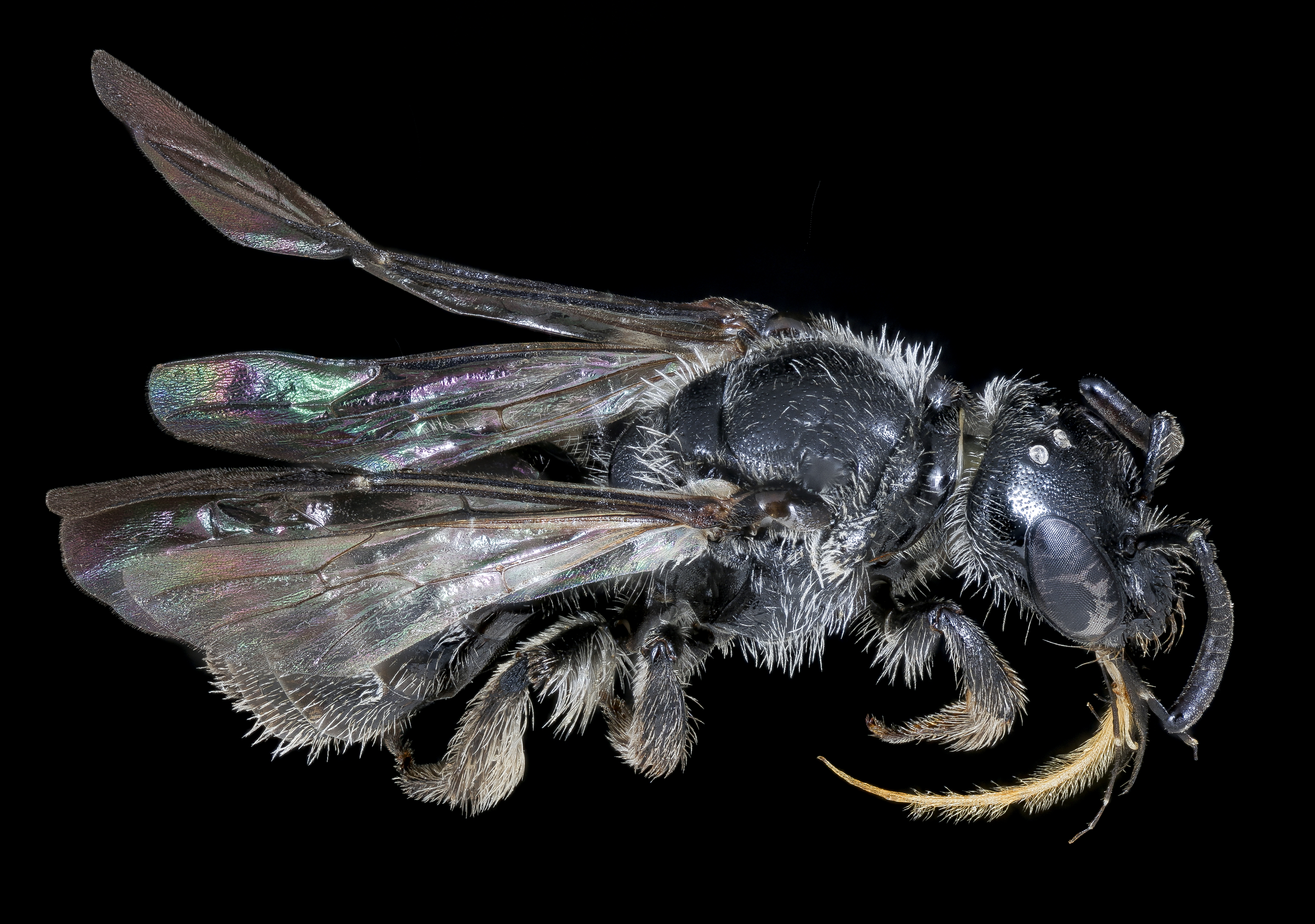
An all black bee, Dufourea monardae
There are a wide variety of studies in native bees, but educating the public is one of the best ways to encourage native bee conservation. So this World Bee Day, take some time to read up on pollinators, and learn what you can do to help our native bees.
On this World Bee Day, we ask: why are bees so fascinating?
Is it their honey or their hive, or is it because they can jive?
USGS
On this day nearly three centuries ago, Anton Jansa was born into a family of Slovene beekeepers. He joined the family business and went on to revolutionize beekeeping. To celebrate his contributions and the insects he spent his life studying, May 20th is designated as “World Bee Day.” But the day is also about much more than just that.
Every time you eat a bowl of vegetables or fruit, chances are you have a bee to thank for it. 35% of the world’s food crops depend on pollinators like honey bees, bumblebees, stingless bees, butterflies, hummingbirds, wasps and many others. Despite being so valuable, they face unprecedented extinction rates from human actions. Something that each of us can do to combat this is to not only educate others on the contributions of pollinators, but to shed light on how incredibly cool they are.
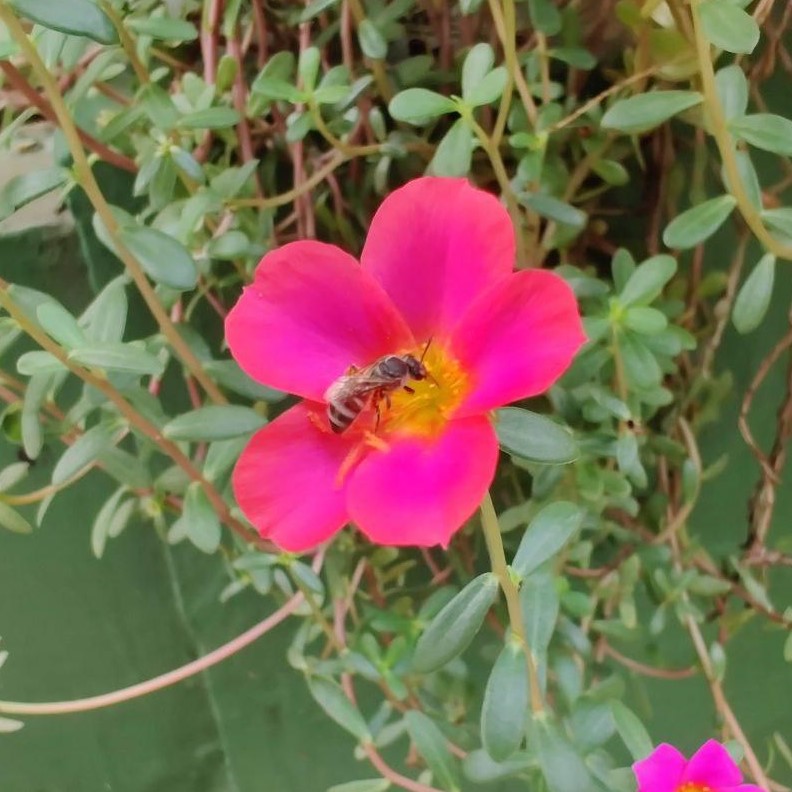
Apis florea pollinating flower
Ebi Antony George
In that spirit, let me tell you a few things about honey bees that will leave you amazed.
Honey bees have one of most unique communication systems. When a bee finds a nice, juicy flower patch, it tells its nest mates by doing a waggle dance. This dance relays the location (direction and distance) and perceived quality of the nectar source. Varying dialects of the waggle dance are used by different honey bee species to accommodate for different foraging ranges, likely dependent on food availability in their environment.
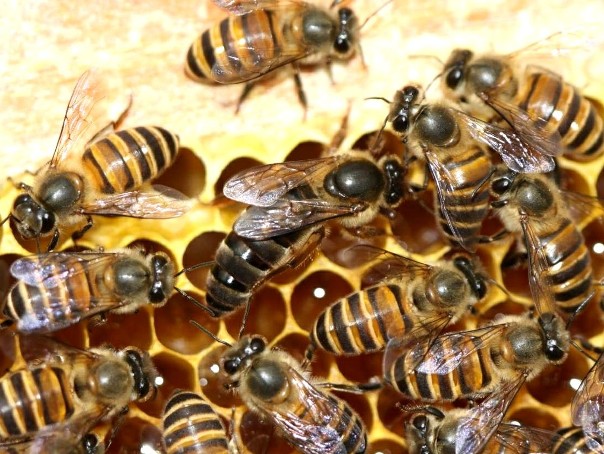
Apis cerana queen
Wikimedia
Honeybees, as well as a few other species, also have a distinctive way of reproducing called "haplodiploidy". Male drones develop from unfertilized eggs and female workers from fertilized ones, and one queen lays all of them. But in one sub-species called Apis mellifera capensis, the workers also lay unfertilized eggs, which develop into daughters. Years after its description, scientists recently discovered the gene responsible for biological anomaly.
All of this only scratches the surface of honey bee biology and comes from decades of research. Unfortunately, studies on other bees are grossly lacking. But with pollinator populations dwindling, it’s crucial that we learn as much about them as possible to come up with better solutions for their conservation.
























